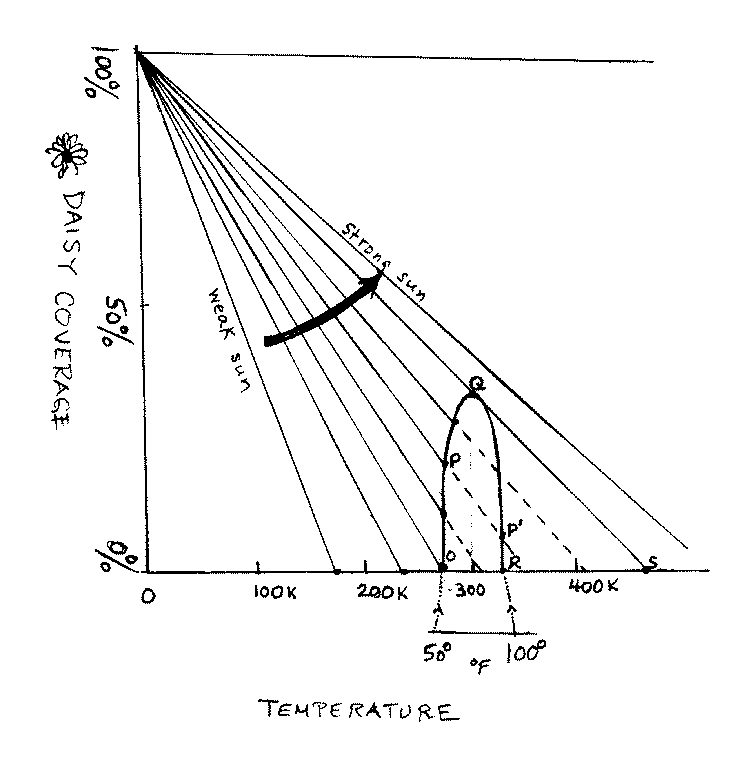
The lecture focused on the above
diagram which was constructed as
described in the text. It
is based on two separate relationships
that govern the climate of Daisyworld.
The first of these
relationships is that the larger the fraction of
the surface of the planet that is
covered by white daisies, the
higher the albedo, and consequently
the cooler the planet. You can
see this relationship more clearly
if you rotate the diagram
counterclockwise 90 degrees so that
the DAISY COVERAGE axis is along
the bottom. (The DAISY COVERAGE
scale will go backwards but that
doesn't matter.) The family
of diagonal lines describes the
equilibrium temperature of the planet
for various fractions of daisy
coverage ranging from 0% on the
right to 100% on the left. Each line
corresponds to a different luminosity
of Daisyworld's sun. The more
luminous the sun, the warmer the
temperature. If the sun is weak,
the temperature of Daisyworld will
be cold, even if there are no
daisies present to whiten the surface.
If the surface is 100%
covered by daisies, the planet will
reflect all the solar radiation
impinging on it back to space without
absorbing any of it, so its
equilibrium temperature will be
absolute zero, regardless of how
luminous the sun is.
The second relationship
involves the influence of the temperature of
the planet upon the daisy coverage.
Here we try to simulate the
biosphere on earth. We assume
that the daisy's favorite temperature
is 300 K (i.e., the temperature
at which they will cover the maximal
fraction of the surface of the planet).
300 K corresponds roughly to
the temperature of the tropics on
earth. We assume that they can
survive only within some limited
temperature range, here assumed to
be 50-100 degrees F, which corresponds
to 283-311 K. Hence the
fractional daisy coverage, in equilibrium
with the temperature This
relationship is seen most clearly
when the figure is viewed as
presented, with the TEMPERATURE
axis at the bottom.
Now suppose that
we start out with a very faint sun in Daisyworld's
early history and let the sun's
luminosity gradually increase with
time, just as it has in the earth's
history. At first the surface of
the planet will be too cold top
support daisies so the daisy coverage
will be 0%. The state of the system
will move from left to (point
O). As the luminosity increases
further, daisies begin to grow. As
daisies grow, the albedo of the
planet increases so that it reflects
a larger fraction of the incoming
solar radiation without absorbing
it. Hence the planet
doesn't warm nearly as rapidly in response to
the increasing luminosity as it
did when the temperature of the
planet was too cold to support daisies.
Instead of following along
the x-axis, the state of the planet
goes up the hump past point P.
As the state approaches the top
of the hump Q, the daisy coverage
begins to level off and the temperature
of the planet begins to
increase more rapidly in response
to increasing solar luminosity
until it reaches point Q, which
marks the optimal temperature for the
daisies. Any further increase in
luminosity will cause daisies to
begin to die off, lowering the albedo,
making the planet warmer,
causing more daisies to die off,
etc., etc. until the daisies are all
gone. This catastrophe will
happen very rapidly and once the daisies
are gone the temperature of the
planet will be much hotter than it
was when they were present (i.e.,
the state of the system would jump
from Q directly to S in just the
time it takes the daisies to wilt).
Hence, the daisies are able to maintain
the temperature of the planet
in the range between their lower
limit for survival and their optimal
temperature for a remarkably long
time just by 'doing their thing',
but once the planet reaches their
optimal temperature, their
population abruptly 'crashes'.
Points like P
that lie along the left side of the hump represent
stable equilibrium states of the
system. Suppose invaders come in
and pick a few daisies and then
leave. The reduction in daisy
coverage will increase the albedo
of the planet, causing it to warm.
A warmer planet will support more
daisies. Hence the daisies that
the invaders picked will grow back.
If the invaders plant daisies,
the planet will cool to a level
less favorable for daisies and the
extra daisies will die off.
Points like P'
that lie along the right side of the hump represent
unstable equilibrium states of the
system. Suppose the planet is in
one of these states and invaders
come in and pick a few daisies and
then go home. The reduction
in daisy coverage will increase the
albedo of the planet, causing it
to warm. A warmer planet will
support fewer daisies, so daisies
will start dying, causing the
planet to warm more until all the
daisies are gone. If the invaders
plant daisies, the planet will cool,
and more daisies will start
growing, cooling the planet, enabling
more daisies to grow until
daisy coverage reaches the value
at the top if the hump. In either
case the system reacts in a way
that causes the state to depart from
the equilibrium state, rather than
return to it.
So if we ran the
experiment in reverse and started with a strong sun
with a luminosity so strong that
Daisyworld was too hot to support
daisies, and if we gradually reduced
the luminosity what would
happen? In this case the state
of the system would start near S move
from right to left along the x-axis
until it encountered the base of
the hump R. Then it would
jump abruptly to the top of the hump Q and
then descend slowly down the left
side. It would be the exact same
sequence in reverse, but for one
difference: in this case, the points
between points R and S wouldn't
be bypassed.